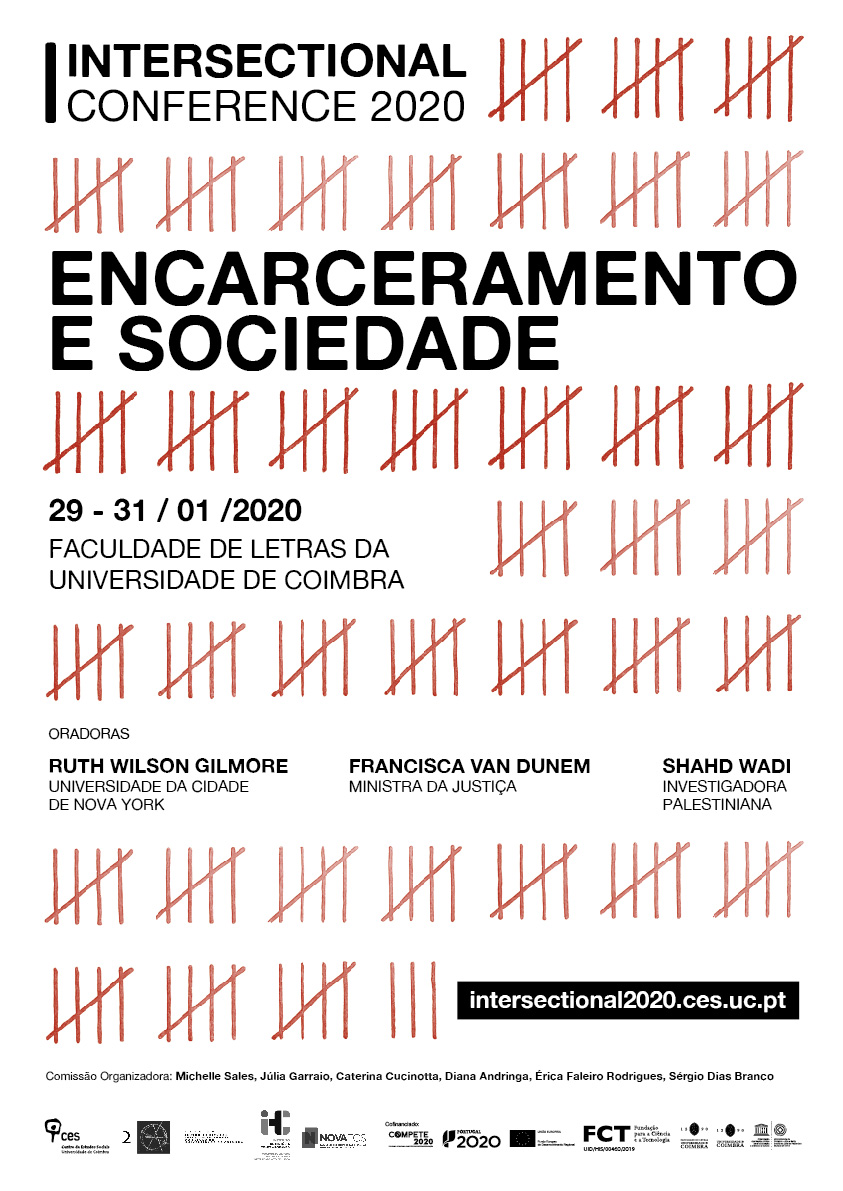I Intersectional Conference 2020
Encarceramento e sociedade
January 29 to 31, 2020
Faculty of Arts and Humanities, University of Coimbra
About
In his book The Racial Contract (1997), the African American philosopher Charles W. Mills describes how western white supremacy has created a system of unnamed power that carries with it a social and political structure conducive to the full exercise of a racialised State and judicial system, capable of determining, and legislating over, the life and death of the bodies it subjugates. It is in this sense that Whiteness, as an established power system, can determine, in those countries with a history of slavery and colonialism, the hegemony of ‘Whites’ in all spheres of society, in contrast to the imposition of a marginalised and lesser social place upon the racialised bodies of ‘Blacks’, ‘Latinos’ and other non-white minorities. One of the places reserved for the subjugated body is the prison.
Take the USA, for example. In the last four decades, it has seen a disproportional rise in the levels of imprisonment, even though crime rates have fallen (Stemen, 2017). As Michelle Alexander asserts (2010) the policies that engender the mass incarceration of black youth in [the USA] perpetuate the negation of full citizenship to African Americans. This negation is at the bottom of the country’s foundation; a country which, as is widely known, rose not just from the conquest, suppression and even extermination of indigenous peoples, but also from the institutionalisation of slavery and exploitation of the racialised body. Researchers and activists such as Angela Davis have been calling attention precisely to the present commercial exploitation of work in prisons by private enterprises, as phenomenon which betrays the entanglement and convergence of capitalism, the modern State, racism and the mass media.
The situation in Brazil is similar. According to data published by Infopen [Brazil’s prison statistics information system], 94% of the Brazilian penal population is male and under the age of 30, and 65% is either black or mixed-raced; pointing to how Brazil’s “industrial detention system” sustains a seminal relationship with its colonial, slavocratic and racist past.
But even in Portugal, one of the countries in Europe with the lowest crime figures, the rates of incarceration still hover above average, leading to a problem of overcrowding, in some cases reaching 200%. Portuguese law prohibits the ethnic or racial profiling of the country’s prison population, making it difficult to visualise, through statistical data, to what extent Portugal’s judicial and prison system may be permeated by racial discrimination. Simple observation, however, points to a percentage of black and Roma inmates well above each group’s share of the general population.
This logic of exclusion and marginalisation, which is based upon processes of racialisation, does not confine itself to the prison system, but rather extends across the social fabric to emerge with violence in rural as well as urban areas.
But the Portuguese case, as that of other European countries, is fundamentally different from the USA’s or those of Latin American countries, since the latter, having gained independence through the efforts of their colonisers’ direct descendants, tend to, almost naturally, prolong patterns of enslavement in the form of continued discrimination. In Europe, and specifically in Portugal, there is a clear temporal gap between the introduction of the black African slave and the waves of immigration taking place in the 1960s and especially the 1970s.
Furthermore, if in Brazil and the USA independence was driven by the descendants of colonisers, in the case of the African colonies of European powers it has instead been powered by indigenous populations, leading to a clear interruption in the slavery/forced work system and giving those who emigrate to Europe – namely to what may have once been a colonial metropolis – a statute rather diverse from that of the African American (an important point to be addressed in this conference). One must not forget all the conflicts that put an end to colonisation, which, in the case of Portugal, took the form of an armed struggle spreading over 3 different colonies.
Also, with regards to Brazil, Jaime Amparo notes, in his book The Anti-Black City: Police Terror and Black Urban Life in Brazil (2018), that metropolises such as São Paulo and Rio de Janeiro can be construed as being anti-black and black, since both include a strong apparatus for building social exclusion, school absenteeism, and the consequent confinement and marginalisation of the black and non-white life and body, instituted by a racialist State, and reproduced by racist media.
The women racialised through spaces marked by European (and other!) colonial legacies face multiple forms of oppression. It was with the aim of confronting this state of affairs that African American women created, towards the end of the 19th century, the National Association of Colored Women’s Club, shortly after the first feminist association had appeared in the USA, composed entirely of white middle class womenfolk. United as a political voice against racism, under the motto “Lifting as we climb”, these African American women congregated around the strong conscience that the fight against machismo required a different approach between white and black women. It is in this sense that they became pioneers, signalling the need to understand oppression and the exclusion of women around the world as a phenomenon propelled by a variety of factors, from social standing to economic power, and ethnic and racial affiliations, amongst others.
Davis has called attention to the fact that, in the USA, black women are four times more likely to be arrested than their white counterparts. She has also noted how skin colour strongly affects the relationship African American women have with the health, school and housing structures, for example. But other minorities and vulnerable bodies – LGBTQI, people with mental health problems, migrants, etc – also suffer with greater intensity and violence the consequences of a punitive system which, more than a means to controlling ‘crime’, is a powerful mechanism for social control. This is a pivotal problem in a debate that has grown in urgency about penal abolitionism.
The conference aims to probe and explore the theme of “Incarceration and Society” through an interdisciplinary approach that strives to inscribing it in the spaces marked by European colonialism and its legacies. It welcomes contributions from a range of research areas and disciplines, such as history, sociology, religion, arts and humanities; favouring intersectional approaches that cross gender, class, race, nationality and ethnic concerns.
Topics of interest:
Public space and surveillance
Democracy and power
Segregation
Prison administration
Human rights
Territory
Violence
Whiteness
Biopower
The legacy of slavery
Penal abolitionism
Feminisms
Artistic and cultural representations
Slavery and capitalism
Human trafficking
Modern slavery
[FREE ENTRANCE]
References:
Alexander, Michelle (2010). The New Jim Crow. Mass incarceration in the age of colorblindness. New York: The new press.
Amparo, Jaime (2018). The Anti-Black City: Police Terror and Black Urban Life in Brazil. Minneapolis: University of Minnesota Press
Davis, Angela (1981). Women, Race, & Class. New York: Random House
------------------ (2003). Are Prisons obsolete? New York: Seven Stories Press.
------------------ (2005). Abolition Democracy: Beyond Prisons, Torture, and Empire. New York: Seven Stories Press.
Mbembe, Achille (2013). Critique de la raison nègre. Paris: La Découverte (« Cahiers libres »).
Mills, Charles (1997). The Racial Contract. Ithaca: Cornell University Press
Stemen, Don (2017). The Prison Paradox: More Incarceration Will Not Make Us Safer. New York: Vera Institute of Justice.
Organization:
CEIS20 – Center of 20th Century Interdisciplinary Studies (UC)
CES- Center for Social Studies (UC)
IHC – Institute of Contemporary History (NOVA - Lisboa)
FLUC - Faculty of Arts and Humanities (UC)
Organising Committee:
Michelle Sales (CEIS20)
Júlia Garraio (CES)
Caterina Cucinotta (IHC)
Diana Andringa (CES)
Érica Faleiro Rodrigues (IHC)
Sérgio Dias Branco (CEIS20)
Scientific Commission:
Ana Cristina Pereira, Centro de Estudos de Comunicação e Sociedade (CECS)/ Universidade do Minho
Ana Oliveira, Centro de Estudos Sociais (CES)
Aurora Almada e Santos, IHC - Universidade NOVA de Lisboa
Carla Cerqueira, Centro de Estudos de Comunicação e Sociedade (CECS)/ /Universidade do Minho
Caterina Cucinotta (IHC)
Diana Andringa (CES)
Érica Faleiro Rodrigues, Instituto de História Contemporânea, IHC - Universidade NOVA de Lisboa
Fernanda Bruno, Universidade Federal do Rio de Janeiro
Júlia Garraio (CES)
Julião Soares Sousa, Centro de Estudos Interdisciplinares do Século XX (CEIS20)
Marisa Gonçalves, Centro de Estudos Sociais (CES)
Michelle Sales (CEIS20)
Pablo Assumpção, Universidade Federal do Ceará
Rita Luís, IHC – Universidade NOVA de Lisboa
Rui Bebiano, Centro de Estudos Sociais (CES)
Sérgio Dias Branco, Centro de Estudos Interdisciplinares do Século XX (CEIS20)


